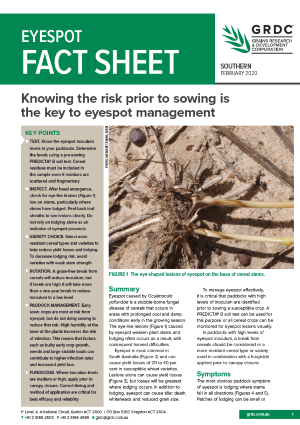Eyespot factsheet
Eyespot factsheet
Published: 1 Feb 2020
Eyespot caused by Oculimacula yallundae is a stubble-borne fungal disease of cereals that occurs in areas with prolonged cool and damp conditions early in the growing season. The eye-like lesions (Figure 1) caused by eyespot weaken plant stems and lodging often occurs as a result, with consequent harvest difficulties.
Eyespot is most common in South Australia (Figure 2) and can cause yield losses of 20 to 40 per cent in susceptible wheat varieties.Lesions alone can cause yield losses (Figure 3), but losses will be greatest where lodging occurs. In addition to lodging, eyespot can cause tiller death, whiteheads and reduced grain size.
To manage eyespot effectively, it is critical that paddocks with high levels of inoculum are identified prior to sowing a susceptible crop. A PREDICTA® B soil test can be used for this purpose or all cereal crops can be monitored for eyespot lesions visually.
In paddocks with high levels of eyespot inoculum, a break from cereals should be considered or a more resistant cereal type or variety used in combination with a fungicide applied prior to canopy closure.
Download PDF
Region: South
GRDC Project Code: DAS1306-008BLX, DAS1807-005BLX,

